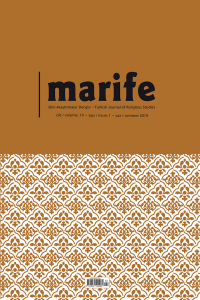
Marife Dini Araştırmalar Dergisi
Yazarlar: Ali ÇOBAN
Konular:Din Bilimi
DOI:10.33420/marife.779297
Anahtar Kelimeler:Tasawwuf,Musannifak,Zayniyya Order,Hallü’r-rumūz,Mathnawī Commentary
Özet: The Ottoman Empire’s, which had a life of over six hundred years, religious thought as well as its state structure, administrative and scientific organization is shaped throughout centuries. In addition to be the inheritor of the previous 6-7 centuries of experience, the Ottomans’ ability to attract immigrant scholars to its lands was also effective in this shaping process. In particular, bringing famous scholars in the Islamic world to the Ottoman lands was implemented by Fatih Sultan Mehmed as a policy. Thus, a movement took place in the scientific and intellectual life of the Ottoman Empire. Within the scope of this policy, Sheikh Ali Bistamî / Molla Musannifek, who came to Anatolia from Khorasan, is an important name. Musannifek took lessons from the students of Sâdeddîn et-Taftâzânî, one of the leading names that formed the Ottoman religious thought. He is also a representative of Zayniyyah group, which was able to attract important names in the 15th century Ottoman Empire. Referring to himself as Sheikh Ali in his works and poems, Musannifek’s full name is “Sheikh Ali b. Mecdüddîn Muhammad” and he is a descendant of Fakhraddin Râzî. His date of birth is 803/1400. Musannifek moved to Anatolia in 848/1444 and died in Istanbul in 875/1470. His grave is near the tomb of Abu Ayyub el-Ansari. In Anatolia, Musannifek reviewed some of the works he had written before and produced new works in Arabic and Persian. The fields he wrote cover both higher sciences (tafseer, jurisprudence etc.) and instrument sciences (fields related to language used while studying higher sciences). His works are generally a type of commentary and are based on the fundamental texts accepted in the Islamic world. Musannifek has also a Sufi side and at least two works on Sufism (mysticism). These are the “Commentary on Mathnawi” and “Hall al- rumûz”. The Mathnawi commentary of Musannifek, which could not gather enough interest, is one of the first examples of the Ottoman Mathnawi commentary literature. This work, which is the commentary of only the first seven couplets of the Mathnavi, is also the largest commentary of the Mathnavi. He started the work in 845/1441 and finished it in Bursa on 15 Shawwâl 845/26 February 1442 in the same year. Some of the certain phrases in this work indicate that it was actually planned to be full commentary on the Mathnawi. One cannot suggest that Musannifek’s detailed and highly valuable commentary on Mathnawi which is written in Mathnawi’s own language has gained recognition by the next generations and inspired the tradition. Hall al-rumûz and Kashf al-künûz is another Sufism related work of Musannifek. This work is a commentary of a small pamphlet of Maktul/Murdered Suhreverdi’s known as Risâlat al-Abrâc. This commentary was ordered by Fatih Sultan Mehmed. The reason why this concise epistle of Maqtul Suhravardî, who is the founder of Ishrâqî school, was ordered to a Zaynî sheikh is that the work is from “indulgence sciences”. The author prepared the commentary directly in a Sufî manner. Before starting the commentary, Musannifek wrote a wide preface on the issues of Sufism. This section is more important than the commentary itself. Musannifek sees Sufism as a compiled science. He claims that every science has specific fields of study and Sufism’s are sâlik (a follower of Sufism) himself who makes the sharia solid, corrects the creed, cleans his intention. According to Musannifek, the issues of Sufism are the states of sâlik that meet the above conditions. For, in that science, the situations in which the sâlik comes closer to his Lord and went away from him are mentioned. Musannifek, who identifies Sufism as a compiled science, states that it is a religious and ladunnî science. Another feature of this science is that it is qashf This quality is a feature that distinguishes it from istidlalî sciences. Another feature of this science is that it is a closed one. That science depends on obedience to the prophet both on what is seen and unseen, trying to be pious and avoiding the corruption of soul and the troubles of desire. It is a science that only appears in the hearts of that kind of people and closed to the others. It is seen that Musannifek followed the traces of the Sufism tradition in the period of muteqaddim in the formation of Sufism as a science. He tries to prove and justify Sufism as a religious (shar‘i) science rather than forming it as a metaphysical entity. While he was forming the Sufism as a science, he did not put existence and issues related to existence in the center as opposed to what Sufis of muteakhhir period had done. Musannifek tries to build the Sufism on sâlik and the spiritual states that a sâlik goes thorugh the path of Sufism.